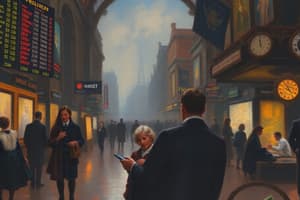Podcast
Questions and Answers
What is the primary role of money in the economy?
What is the primary role of money in the economy?
- To facilitate barter trade between commodities
- To act as a medium of exchange and unit of production
- To determine the value of goods based on supply and demand
- To serve as a store of value, medium of exchange, and unit of account (correct)
What is a significant disadvantage of the barter system that money addresses?
What is a significant disadvantage of the barter system that money addresses?
- The need for a double coincidence of wants (correct)
- Difficulty in storing value over time
- The limitation on trading perishable goods
- Inefficiency in international trade transactions
Which of the following best describes the meaning of M1 in the money supply?
Which of the following best describes the meaning of M1 in the money supply?
- Currency in circulation, demand deposits, and traveler's checks (correct)
- Only savings deposits and time deposits
- All forms of currency including cryptocurrencies
- Investments in fixed assets and real estate
What distinguishes derivative financial instruments from primary financial instruments?
What distinguishes derivative financial instruments from primary financial instruments?
What does the formula for calculating compound interest represent?
What does the formula for calculating compound interest represent?
Flashcards
Double Coincidence of Wants
Double Coincidence of Wants
The need for two parties to have something the other wants to exchange goods without money.
Derivative Financial Instrument
Derivative Financial Instrument
A financial instrument that derives its value from an underlying asset, such as a stock or commodity. It has no intrinsic value itself.
Financial Instrument
Financial Instrument
A contract that gives rights to one party, but also creates an obligation for another party.
Payment System
Payment System
Signup and view all the flashcards
Equity Instrument
Equity Instrument
Signup and view all the flashcards
Study Notes
Financial Markets and Institutions
- Understanding financial markets and institutions is crucial for comprehending how money flows through the economy.
- These entities facilitate the flow of funds from savers to investors, thereby contributing to economic growth.
- Money's primary roles are as a medium of exchange, a store of value, and a unit of account. This directly addresses the inefficiencies of the barter system, requiring a double coincidence of wants.
Money Supply and Demand
- M1, a measure of money supply, primarily includes currency in circulation, demand deposits, and traveler's checks.
- Speculative demand for money arises from expectations of future interest rate changes.
- The Quantity Theory of Money describes the equation M × V = P × Y, indicating nominal GDP equals the money supply multiplied by velocity. This equation signifies equality of nominal GDP to the money supply and national debt (not explicitly stated in prompt but implied).
Compound Interest and Payment Systems
- Compound interest is calculated using the formula: Cl = P(1+r/n)ⁿᵗ - P
- A payment system is the method for conducting economic transactions.
- Fiat money, a disadvantage, is heavy and difficult to transport.
- Checks offer more practical solutions, providing payment receipts.
Financial Instruments
- A financial instrument creates a financial asset for one entity and either a liability or equity for another.
- Examples of financial assets include trade payables and bonds.
- Derivatives, unlike primary instruments, derive value from other assets.
- An equity instrument represents the residual interest in an entity's assets after liabilities are subtracted.
- A forward contract involves a specific delivery date and isn't traded on an exchange.
Studying That Suits You
Use AI to generate personalized quizzes and flashcards to suit your learning preferences.
Description
This quiz explores the fundamentals of financial markets and institutions, emphasizing their roles in the economy and the movement of money. It also covers concepts related to money supply and demand, providing insight into measures like M1 and the Quantity Theory of Money. Test your knowledge on how these components interact within the economy.




